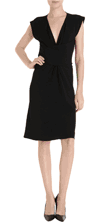Textiles, Merchandising and Fashion Design, Department of

Department of Textiles, Merchandising and Fashion Design: Dissertations, Theses, and Student Research
First Advisor
Mary Alice Casto
Second Advisor
Claire Nicholas
Date of this Version
Spring 4-2022
Document Type
Thesis
Citation
Kuhlman, A. (2022). The Making of Everyday Hollywood: 1930s Film Influence on Everyday Women’s Fashion In Nebraska [Master’s Thesis]. University of Nebraska-Lincoln.
Abstract
This research examines the influence of film fashions on middle-class, Nebraskan women’s dress during the Great Depression (1932-1940). The Great Depression challenged the middle class: while standards of living remained high, the economic means to achieve those standards diminished. Despite the crisis, women strove to keep up with current fashion trends. While previous literature has examined how Hollywood directly affected trends and styles of the 1930s in major American metropolitan contexts, the manifestation of trends in the dress of middle to lower socio-economic classes in Middle America remains under-examined. Against the backdrop of Depression-era hardships specific to Nebraska’s agricultural economy, itself anchored to the financial and banking sectors of the time, this study contributes to the diversification of class and geographic specificity in fashion history.
Using material culture and historical methodologies this study examined primary sources: films, cinema magazines, Vogue, extant garments, and photographs. Five films, selected in terms of popularity and influence during the period, were examined for fashions and trends. Magazines, garments, and photographs of ordinary Nebraskans were analyzed to determine how middle-class women’s dress expressed or modified film fashions. Popular film fashions were compared with contemporary fashion trends as presented in Vogue, a key fashion communicator across socio-economic classes. Findings revealed that Hollywood’s role as a fashion influencer was more as a promoter rather than as an innovator as similar fashions and design elements were seen in Vogue before a film’s release. Furthermore, middle class women were more likely to copy key design elements and silhouettes rather than complete looks, sometimes combining elements of multiple different film fashions. Common modifications included materiality, hem length, and non-key design details. Thus, women adapted film fashion to their everyday needs and tastes.
Advisor: Mary Alice Casto
Included in
Cultural History Commons, Fashion Design Commons, United States History Commons, Visual Studies Commons, Women's History Commons


Comments
A THESIS Presented to the Faculty of The Graduate College at the University of Nebraska In Partial Fulfillment of Requirements For the Degree of Master of Arts, Major: Textiles, Merchandising & Fashion Design, Under the Supervision of Professors Mary Alice Casto & Claire Nicholas. Lincoln, Nebraska: May, 2022
Copyright © 2022 Anna Kuhlman